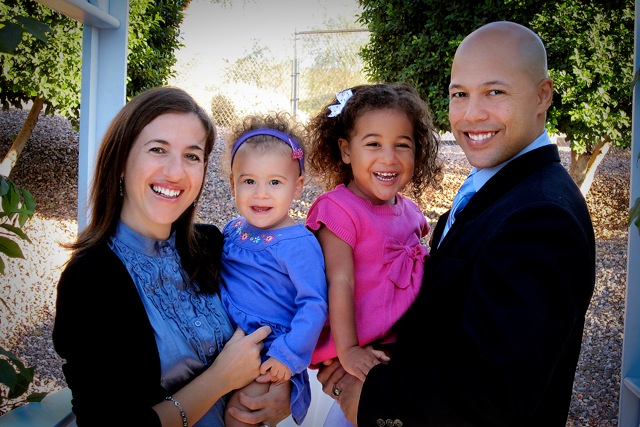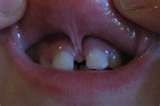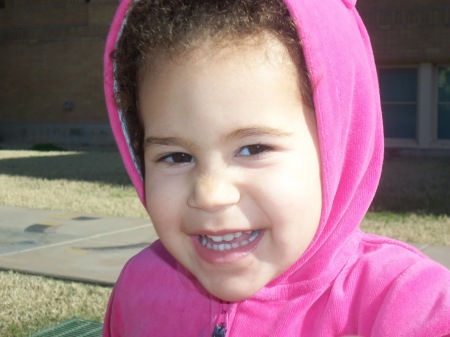
By Guest writer Alessia Mogavero
‘OUR ADVENTURE’ PART ONE – (Frenulum Linguae) 
When our second daughter was born, in August 2009, I was in terrible pain while nursing her, so I went to see my lactation consultant, Lori, who had helped me to nurse my first daughter correctly. When I told her that nursing Myla was actually more painful than it had been with Keira, she opened Myla’s mouth and immediately found the reason for that excruciating pain: a very thick frenulum linguae, under her tongue, commonly called ‘Tongue Tie’.
She showed us a book with some pictures of babies with that problem and pictures of the specific soreness on the Mom’s nipples (different than the ones caused by a wrong positioning of the baby at the breast). In the same book, there were pictures of older children or even adults, whose frenulum was so thick it didn’t allow the tongue to move as freely as it should. Lori also shared with us a very informative Powerpoint presentation by Dr Brian Palmer, where we could observe different kinds of frenula, their level of seriousness and how thick they can become with age, when not clipped at birth (http://www.brianpalmerdds.com/pdf/frenum_pdf.pdf).
We immediately opted for a clipping (frenotomy) to be done as soon as possible, considering my pain during breastfeeding and Myla’s obvious impediment in even sticking her tongue out of her mouth. Imagine how uncomfortable it is to have your tongue stuck to the bottom of your mouth! Some babies have serious problems breastfeeding (see the story of the baby from Hawaii, below), others might develop a speech impediment that could affect not only the normal development of their personality and self-esteem, but also their education and their whole life.
Well, what seemed as obvious to us seemed not-so-obvious to everybody else! This is where our ‘adventure’ started.
When we took Myla to the pediatrician’s office (our pediatrician was having a baby herself, so we had to see another doctor at the same practice), she claimed that ‘tongue-tied babies are very common, and their sublingual frenulum goes away with time’. True? Well, the book we had looked at and Dr Palmer’s study showed that, in some cases, they do not go away at all, at least for the kind of frenulum our daughter Myla had. When we voiced our position and asked for a referral to a specialist who would clip Myla’s frenulum, the pediatrician said she didn’t have any referral to give us, as no doctor in that practice endorses clipping frenula in babies. I mentioned my pain in breastfeeding and she suggested that I ‘suffered through that until Myla’s frenulum was gone, or choose to give her formula.’ When we left that office, we were in a mixture of disappointment, anger and frustration.
Once home, we called Lori, our lactation consultant, who sighed (she had already imagined that such an answer could come from a pediatrician, regarding the treatment of a frenulum) and gave us the number of a midwife who could do the procedure on our baby. The clipping, she reassured us, was totally safe. We called the midwife, Pam, set up an appointment that same day, drove to her office and had it done in less than 3 seconds. Myla cried when she had it clipped, and it bled a little, but, as soon as I put her at my breast, she nursed in a way that already seemed different to me. She was totally peaceful after that. My breast healed in a week and she has nursed beautifully for 14 months.
‘OUR ADVENTURE’ PART TWO (Frenulum Labii Superioris)
About one year later, at the end of August 2010, Kevin and I were playing with our daughters in our living room and, for the first time, we noticed that Myla had a ‘strange’ smile: her lips would cover her upper front teeth completely, and none of us in the family has that problem.
Instinctively, I pulled her upper lips up and, there it was: a thick piece of tissue in
 between her teeth, which linked her gums to her lip much lower than what all of us had. Kevin and I looked at each other and instinctively knew that this frenulum too was there when she was born. However, this one was much thicker than the one we had clipped. ‘Oh, boy! Will the midwife be able to clip this one too?’, we wondered.
between her teeth, which linked her gums to her lip much lower than what all of us had. Kevin and I looked at each other and instinctively knew that this frenulum too was there when she was born. However, this one was much thicker than the one we had clipped. ‘Oh, boy! Will the midwife be able to clip this one too?’, we wondered.
That same night, I spent hours on the internet, trying to learn more about frenum/frenulum and how to get rid of them. I found some feedback from people that had it removed at their dentist’s office from an oral surgeon and all of them said, “The sooner you do it, the better!” The parent of a 6-month-old boy said it was ‘a walk in the park’, while a 70-yr-old woman said it was so painful to have the frenectomy done in order for her dentist to put dentures in her mouth (the frenum was ‘in the middle’ and needed to be removed), she wishes she had not done it at all and had rather stayed with no dentures and no teeth! None of them, however, specified what kind of procedure they had done (if with stitches or not) – they just called it ‘frenectomy’.
The day after, I called Lori, our lactation consultant, and she said that this frenulum could not be just clipped, as it was already thick, and suggested that we went to see an ENT (Ear-Nose-Throat specialist) she had just visited herself for family reasons and had had a good experience with. In order to see a specialist, however, you have to first obtain a referral from your doctor, so I went to see our pediatrician (the one who was giving birth a year before). I explained the situation to her, saying that we were sure this frenulum was already there when Myla was born and now it had got thicker. I also said that Lori, who she knew very well, as she had referred me to her two years before, was suggesting that we went to see a specific ENT, and we were willing to go show him Myla as soon as possible.
To my surprise, our pediatrician said there was no reason to be so upset over something ‘so small’ if compared to Myla’s heart murmur and that we should focus on seeing a cardiologist first. She added that frenula usually go away with time, that this one was not creating Myla any feeding problem, therefore, in a couple of months, I could just show it to a pediatric dentist and see what he might think. Once home, I told my husband what she had said and asked him, ‘Do you think that we are making a fuss over anything and that, this being only ‘esthetical’, we should let it be?’ He was very upset about our pediatrician’s response, and said, ‘Absolutely not! This frenulum is NOT going to go away, as we well know and have seen in the book and in Dr Palmer’s study. What are we waiting for? That she turns 14, has a huge gap between her teeth, not to mention a much thicker frenulum that doesn’t even allow her to smile normally, and that she needs to remove it then, and get braces at a huge financial expense on our part? Nonsense! If we take it off now, she might need braces anyway, but if we leave it there, she will need them for sure. To me, the answer is obvious: let’s get it done Now!’
Having decided that, I called our pediatrician’s office again, told the secretary we had decided this was important to us and wanted it checked by a specialist as soon as possible, and asked to have the referral to the ENT I had been advised about. The secretary said she would talk to the doctor and let me know. In the meantime, that evening, I kept on researching information online and found some different kind of frenectomies for labial frenula. Youtube.com has excellent videos, so I found there were at least three ways to the procedure: Z-plasty surgery, the traditional way with scalpel and scissors and stitches and, lastly, laser surgery.
A few months before, our pediatrician had given me her personal e-mail address, as she was changing practice and that was the way to communicate with the patients who wanted to follow her. Therefore, inspired by the information I had found, I shared it with her through e-mail and I also sent her Dr Palmer’s Powerpoint presentation. The morning after, I received a phone call from the pediatrician’s secretary, who told me, in a very dry tone, that I was not supposed to use the doctor’s private e-mail address and that I had to bring Myla back in, if I wanted any referral from them at all. I was so frustrated and discouraged after that! I had sent her that e-mail with the best of intentions and the answer I got was not at all what I had expected. Rather, the opposite! My husband was furious and said, ‘You stay home. I’ll go’. The doctor ended up not giving my husband a referral to the ENT Lori had suggested, but a list of other ENTs. Therefore, we called the ENT’s office we had been advised on the first place, we fixed an appointment and then called the pediatrician’s office and asked them (with every ounce of patience we had left, as I am sure they felt the same way with us) to fax their referral to this specific ENT. If I had a specific request, why couldn’t that be satisfied? Why is everything so complicated, in 21st-century America’s medical system??
When we went to see him, he said that 90% of tongue-tied babies have an upper labial frenulum too (as we had thought) and that he clips both at birth or during the first months of life, no anesthesia needed. However, Myla being older than 4 months of age (13 months old), he would need to put her under general anesthesia, use scalpel and scissors, put a couple of stitches and be done in a few minutes. When I asked him how bad he thought her frenulum was, he said, “Significant. And, no, it will not go away with time.”
He sent us home with the papers ready to be filled out with Myla’s information for the procedure. The cardiologist told us her heart murmur was very normal and he could barely hear it, so he approved the general anesthesia for the frenectomy. However, something held us back: the videos I had watched on youtube.com showed that laser surgery was so much easier! Why go through general anesthesia on a little child, when you can have it done in local anesthesia? At this point, our questions were, ‘Is it possible to have laser surgery on a 13-month old? And, if so, who could do it?’ That same night, I thought that asking the leading expert in frenula was the way to go. The leading expert for us was Dr Brian Palmer, who had developed such a detailed study on the problem. Maybe he would address us on the right way. So, here I was now, writing an e-mail to this very important doctor, while a little voice in me was saying, ‘Here we go again! Now HIS secretary will call you, to tell you NOT to use his personal e-mail ever again!’
Well, less than 24 hours later, Dr Brian Palmer in person sends me the following e-mail:
Sept 17, 2010
Hi Alessia
I am retired now. Someone you might want to contact is Dr. Larry Kotlow. He has done, and is currently doing, research on tight frenums. He may be able to consult with you or he may know someone in your area who may be able to help. His contact information is: Lawrence A. Kotlow, D.D.S., P.C.[…]
Hope you find help for your daughter.
For Better Health!
Brian Palmer, DDS
What a great man! I am sure the medical history of the future will give him thanks for all his research on the topic of frenula! Certainly my family and I will!
The day after, Saturday September 18th, I receive this other e-mail:
Alessia:
Brian Palmer forwarded your e-mail onto me for comment. I would go ahead and have a laser frenectomy with no more than local anesthesia performed by an oral surgeon who knows how to do this as soon as possible to prevent further problems. If you live anywhere near Albany, New York Dr. Kotlow performs this procedure very often and is an expert on the subject, perhaps the world’s expert. You can contact him at kiddsteeth.com.
Alison K. Hazelbaker, PhD, IBCLC
That same day, though, I had brought Myla to a periodontist’s, to ask if he performed laser frenectomies. He said he did, but only on children who were 10 years old or older. He would not take the responsibility of perfoming it on little ones, as they move too much and it can be dangerous. He also suggested that we waited until her new teeth came out, and see if the frenulum would get thinner at that point. If it didn’t, he would consider doing it on her then, when she would be 5 or 6 years old, but not before then.
Therefore, even though Dr Hazelbaker’s e-mail gave me encouragement, I wrote:
Dr Hazelbaker,
thank you very much for the referral. Unfortunately, we live in Phoenix, AZ and it wouldn’t be easy for us to reach Albany, NY. Our girl is 1 year old and both an oral surgeon and an ENT told us that a local anesthesia wouldn’t be enough, as my girl is too little and would move too much for them to perform a laser frenectomy. Therefore, we were thinking of waiting until she’s 5 or 6 and then get that done. Hopefully, then, she’ll be ‘wise’ enough to stay still during the shot and the procedure. If you have any suggestions, please feel free to send them our way.
Thank you so much for your time.
This was her reply:
I would strongly encourage you to get a consult with Dr. Kotlow. He does laser surgery on this age child all the time. I am sure he would speak to you on the phone. I also strongly encourage you NOT to wait until she is 5-6. By then she may have developed all manner of compensations like speech delay and dental problems. Now is the time when you have the power to prevent problems from developing.
Alison K. Hazelbaker, PhD, IBCLC
Reassured by her words, I picked up the phone and called Dr Kotlow. He talked to me directly, which I so highly appreciated, and explained that very few doctors and oral surgeons, if any, want to accept the fact that frenula need to be removed early and that laser frenectomies on babies or kids of any age, as well as on adults, are totally safe, fast and give great results with a very short recovery time, if compared to any other procedure. He added that people fly to his office in Albany, NY from all over the place and can fly back home the very next day. The procedure itself lasts only 5 minutes or so. I thanked him so much for reassuring us, and then I gently asked him if he knew of anybody who performed laser frenectomies in Arizona. He answered, ‘Nobody in Arizona that I know of. In California, I know Dr James Jesse. You can contact him and, if he can’t help you, you can call me again. Good luck’.
Another great man! After talking to him, we felt so confident that we were moving in the right direction, doing what was best for our little daughter. But, man, wouldn’t all this be much easier for your family if your pediatrician and your dentist knew too??
When I called Dr. James Jesse, his daughter and assistant was, too, very kind. She explained that:
– only very little local anesthesia was needed on the frenulum, then laser, the whole thing lasting about 5 minutes;
– Tylenol only if the child complains too much after the procedure. When they follow up after 24 hours, parents 99% of the times say the kid is doing great and needed no Tylenol or other drugs at all;
– two weeks from the day of the procedure, you can barely see a scar on that point!
I ask the magic question again, “Anybody in Arizona?” she says she doesn’t think so, but then asks Dr Jesse and he gives me the phone number of a classmate of his in Scottsdale that might do it. (What a great man and professional he is as well, like Dr Palmer and Dr Kotlow! So hard to find, in today’s age!).
I called the doctor in Scottsdale, but his assistant says, “No, he doesn’t use laser. And, wow, on a 1 year old? Oh no, we don’t treat patients that young!” Our new pediatrician defined Myla’s frenulum ‘pretty significant’ and sent a written request to our insurance, to see if they could cover the procedure. In his letter, he mentioned that ‘indications for the surgery include: prevention of potential gum recession, speech articulation defects and front-tooth diastema’ and that laser surgery is to be preferred because, ‘in comparison to traditional surgery, does not require general anesthesia, saving medical risk to this young child, as well as medical costs; perioperative complications and pain are also potentially less’.
While waiting for a reply from our insurance, I called the 22 oral surgeons on their list in the state of Arizona. 19 of them told me they don’t perform laser frenectomies (some of them doubted the fact that frenectomies can be performed with laser, especially on children this young), 1 performed Z-plastic surgery with general anesthesia and 2 very confidently told me that there is no way that laser can be as effective as what they perfom, which is scalpel-and-scissor incision in general anesthesia.
Another pediatric dentist right by our house bluntly told me that he would never put his own kids into such a ‘distress’ as a frenectomy, especially at this young age, and that “the only intelligent thing to do is wait until her new teeth come out.” When I mentioned laser, he literary said it is ‘dangerous’ on kids so little and that the frenulum ‘comes back’ if treated with laser. “Well”, I said, “pretend she’s 10 today and I’m back and the frenulum is still there. Will you remove it, or would you send me to somebody else?” At my words, he lost his patience, left the room, came back with a phone and called somebody, evidently the oral surgeon he works with, in those cases. To everything the surgeon would say, the dentist would add, “I told her! Yes, I told her!” and, after hanging up, he said, “As I told you very clearly already, there is no need to remove a frenulum at this early age! Wait until her new teeth come out and then we’ll see. I am pretty confident the frenulum will be gone by then. Removing it at this age, and with all the risks involved, just wouldn’t make sense!”
At this point, we just realized that a great part of doctors and oral surgeons do not have the right information at hand on the matter of frenula and frenectomies. This is the ‘why’ of this booklet: to raise awareness that, YES, there is a better way! And that the sooner it gets done, the better. When the result from our insurance came back, saying that “the procedure’s expenses cannot be covered by the insurance, as the frenulum does not interfere with feeding, therefore it is only ‘esthetical’ and has to be paid in full by the patient”, we called Dr Jesse in Colton, CA, scheduled the procedure for the following week and got it done.
On, Monday, January 3rd 2011, at 8 am, Dr James Jesse performed a laser frenectomy on Myla. Total length of the procedure, from injection of local anesthetic to end: 6 minutes. The laser procedure itself: 1 minute and 25 seconds. As soon as my husband let go of Myla (he was holding her down during the frenectomy), she stopped crying and enjoyed the popsicle that Dr Jesse’s assistant had nicely given her. We couldn’t believe how fast and simple the whole procedure was! That same evening, we were back home. Myla had been happy as always during the 6-hour drive back to Phoenix, watching dvds with her big sister in the back seat, having another popsicle on the way and an ice-cream after dinner.
As promised, the day after, Dr Jesse’s assistant called us to check that everything was ok. Myla had slept very well that night and had not complained at all about her booboo (she just pointed at it once, saying, ‘Booboo, Mommy’, and, after my kiss, never mentioned it again). No Tylenol was needed. We pulled her lips up and held them for 10 seconds about 6 or 7 times a day for one week, as suggested by Dr Jesse. On day 10, we could barely see the scar. Today, after exactly 1 month after the procedure, you can’t even tell a frenum, a frenulum or a frenectomy happened there! We all enjoy her beautiful smile with her teeth out, not covered by her lips, and her big diastema (gap between her front teeth) is already closing, helping the other two front teeth get in a better position than the lateral one they were growing in before. And, I must add, the whole procedure is very inexpensive, so the fact that our insurance did not cover it was not a big deal. Whichever the price, laser frenectomies, especially when done early in life, are so worth every penny spent to have them done! How much is your child’s smile worth to you?
In my opinion, there is no better way to treat a thick frenulum than Laser Frenectomy, right here, right now, in 21st-century America. The fact that Dr Kotlow and Dr Jesse perform this procedure is a blessing, and the ‘good news’ need to be spread! My best wishes of good luck to you, if you are starting your adventure right now! And a call to ‘join the cause’, if you have had a personal experience with frenula and frenectomies and are willing to share your information with others. Remember, a battle for a cause that can improve people’s lives, bringing them physical and psychological well-being, is always a battle worth fighting!
(FOR VIDEOS, HELPFUL LINKS AND OTHER MOMS’ STORIES ON FRENECTOMY, PLEASE VISIT frenectomytoday.wordpress.com).
Alessia Mogavero was born and raised in Italy and was an English teacher for 5 years, before moving to the USA to marry Kevin, in 2005. They live in Phoenix, Arizona, and have two daughters, Keira, 4, and Myla, 2. Alessia is very passionate about sharing personal experiences that can enrich other people’s lives. In this case, she wants to raise awareness on the Tongue-Tie and Frenulum problem, and how important it is to know that a better method is available today, Laser Frenectomy. Her blog is: frenectomytoday.wordpress.com. If you want to contact Alessia with any questions and/or send your ‘frenectomy story’, please send her an email at alemogo@yahoo.com.



Thank you SO MUCH for posting this! My husband and I have also been going through quite an arduous process with our 6 week old and her tongue-tie. Between my heavy let-down while nursing and having nursed my first daughter for 20 months, I didn’t have the tell-tale nipple pain that often comes with tongue-tie, but my normally sweet-dispostionef baby was terribly colicky and spit-up and vomitted profusely. I knew, though, that it wasn’t just colic or acid-reflux as others tried to convince me. I could tell that my baby was frustrated and I knew there was a logical reason. I did allergy-testing, took her to a chiropractor, everything I could think to do, until one “random” chiropractic appointment when my chiropractor commented, “You do know she’s tongue-tied?” The light bulb went on at that moment! However, when we brought our daughter to our pediatrician the next day for a consultation, she refused to look in her mouth and instead asked to see her nurse. While her bottom lip was unable to create a suction and milk dribbled everywhere and our daughter kept coming off the breast sometimes crying, the doctor chalked it up to my fast let-down and suggested I pump to relieve the pressure (horrible advice all the way around!). A few weeks later, however, we were talking with a nurse and lactation specialist who had heard a local doctor at a breastfeedibg symposium specifically discussing tongue-ties and the difficulties they present at breastfeedibg and common misdiagnosis. Convinced, we called that doctor directly and at our consultation with him pronounced our daughter to have a severe, second degree tongue-tie! However, somehow his office failed to ask us if our daughter had had the vitamin K shot at birth–his personal requirement based on his own experience. We had declined that at her birth, so we are now doing oral vitamin K drops until her procedure next week! Whew! I have been amazed at the over abundance of mis-information regarding tongue-tie. I, too, now have a personal mission to spread the word to mothers everywhere that colic, nipple pain and spit-up (among other issues) may be a result of tongue-tie. And if you suspect it in your child, it’s inoperative to consult with a specialist or other doctor who can accurately diagnose it. Above all, listen to your mother’s instinct and don’t give up until you have complete peace regarding your child’s well-being. Thank you so much for sharing this story and spreading awareness!
Stephanie,
I am so sorry you had to go through all that, with your baby! Yes, unfortunately there is a lot of misinformation around tongue tie and frenums. I would love to post your comment in my frenectomy blog as well, if it is ok with you. I talked with Dr Fred Margolis from Illinois this morning, and he told me about two conferences coming up, in which the topic of tongue ties and laser frenectomy will be exposed by him in person and other professionals. Here are the links:
The Illinois LaLeche League Conference: March 9-11, 2012
http://www.breastfeedingconferences.com/illinois/lll-illinois-area-conference-2012-presents-breastfeeding-roots-wings
For dentists: The Academy of Laser Dentistry’s Pediatric Dentistry and Orthodontic Conference:
http://www.laserdentistry.org/index.cfm/conference/Program
Let’s spread the word!
God bless,
Alessia Mogavero